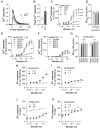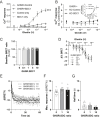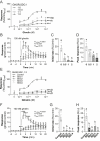Syndecans modulate ghrelin receptor signaling
- PMID: 39565158
- PMCID: PMC11729051
- DOI: 10.1530/JME-24-0070
Syndecans modulate ghrelin receptor signaling
Abstract
Ghrelin is a gut hormone that enhances food intake and growth hormone secretion through its G-protein coupled receptor, the growth hormone secretagogue receptor (GHSR). Recently, we have shown that ghrelin interacts with syndecans (SDCs), a family of membrane proteins known to modulate hypothalamic appetite signaling. Here, we investigated whether SDCs impact ghrelin signaling at GHSR by assessing ghrelin-induced intracellular Ca2+ mobilization (iCa2+) and inositol phosphate 1 (IP1) production in HEK293 cells. Compared with controls, the overexpression of SDCs dose-dependently increased the maximum iCa2+ response two- to four-fold, without affecting EC50. The IP1 response was similarly amplified by SDCs, but it also indicated that they reduce constitutive (ghrelin-independent) activity of GHSR. These enhanced responses occurred despite a SDC dose-dependent reduction in plasma membrane GHSR levels. Although ghrelin-stimulated Gαq activation was unaltered by SDC1 expression, it failed to restore iCa2+ responsiveness in GNAQ/11 knockout cells, indicating dependence on Gαq/11, not another Gα subunit. This suggests that SDCs modulate either signaling downstream of Gαq/11 or quenching of β-arrestin2 recruitment to GHSR. Indeed, expression of SDCs at levels that only modestly suppress cell surface receptor reduced ghrelin-induced β-arrestin2 recruitment by ∼80%. SDC co-expression also delayed the peak β-arrestin2 response. However, peak β-arrestin2 recruitment follows the peak iCa2+ response, making it unclear whether reduced β-arrestin2 recruitment potentiated Ca2+ signaling. Altogether, SDCs enhanced iCa2+/IP1 and reduced β-arrestin2 recruitment by GHSR in response to ghrelin, likely by modulating signaling downstream of Gαq. This could be a novel mechanism through which SDCs affect metabolism and obesity.
Keywords: G protein‐coupled receptor (GPCR); GHSR; ghrelin; signal transduction; β-arrestin.
Conflict of interest statement
The authors declare that there is no conflict of interest that could be perceived as prejudicing the impartiality of the work reported.
Figures





Similar articles
-
Enhanced responsiveness of Ghsr Q343X rats to ghrelin results in enhanced adiposity without increased appetite.Sci Signal. 2016 Apr 19;9(424):ra39. doi: 10.1126/scisignal.aae0374. Sci Signal. 2016. PMID: 27095593
-
Agonism, Antagonism, and Inverse Agonism Bias at the Ghrelin Receptor Signaling.J Biol Chem. 2015 Nov 6;290(45):27021-27039. doi: 10.1074/jbc.M115.659250. Epub 2015 Sep 11. J Biol Chem. 2015. PMID: 26363071 Free PMC article.
-
The GPCR accessory protein MRAP2 regulates both biased signaling and constitutive activity of the ghrelin receptor GHSR1a.Sci Signal. 2020 Jan 7;13(613):eaax4569. doi: 10.1126/scisignal.aax4569. Sci Signal. 2020. PMID: 31911434 Free PMC article.
-
The growth hormone secretagogue receptor: its intracellular signaling and regulation.Int J Mol Sci. 2014 Mar 19;15(3):4837-55. doi: 10.3390/ijms15034837. Int J Mol Sci. 2014. PMID: 24651458 Free PMC article. Review.
-
The ups and downs of growth hormone secretagogue receptor signaling.FEBS J. 2021 Dec;288(24):7213-7229. doi: 10.1111/febs.15718. Epub 2021 Mar 2. FEBS J. 2021. PMID: 33460513 Review.
References
MeSH terms
Substances
LinkOut - more resources
Full Text Sources
Miscellaneous

